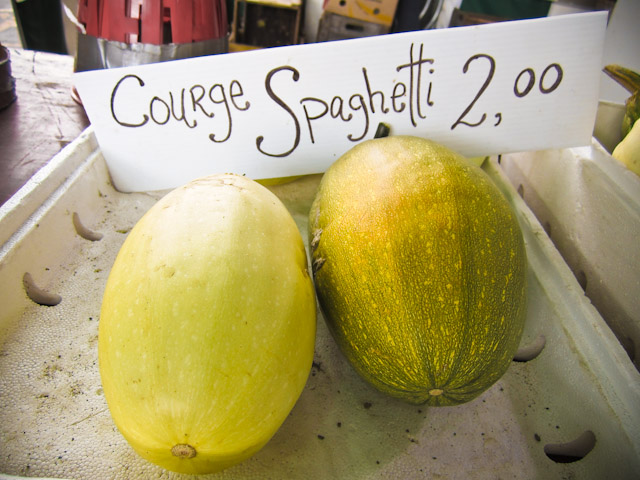Spaghetti squash at the Jean-Talon market in Montreal. A complete delight and mystery, spaghetti squash was my favorite vegetable growing up. Though not terribly popular or widely available in the late 70s, somehow my grandmother was able to procure one at least once a fall. Into the oven as a hard, nubby, squash, then magically out of the oven and onto my plate, transformed into golden pasta-like strands that surprised me each time. Becoming much more common and available now, spaghetti squash are all over the markets (and my garden), and will be for months. It is technically a winter squash--ripening at this point in the season, and able to be kept in cold storage long into the cold weather--but with its golden color and light, buttery texture, is much more reminiscent of summer squash. A welcome bit of variety in a long season of dense, orange-fleshed cousins. Generally the rule of thumb is that spaghetti squash will keep for up to a month in a cool, dry area. Though the past couple of years, we have successfully kept ours that we grew for 3-5 months on a well aerated shelf in our basement, keeping an eye out for any that might be getting soft or imploding. Rubbing the outside surface with a thin coating of vegetable oil is said to keep fungus and mold spores from being able to take root on the surface of the squash, cutting down on deterioration, and extending their shelf life considerably. To cook Wash and dry the squash well, and cut in half lengthwise. This will be the hardest step. Make sure it is well dried, so your knife doesn't slip, and if helpful, cut off a small portion of either end to give yourself a more steady anchor. Scoop out the seeds and stringy flesh surrounding the seeds. Rub the inside of each half with olive oil and place, cut side down, on a baking sheet. Roast in the oven at 375 degrees for 35-40 minutes, until the skin just starts to give when pressed with your finger. Don't over cook, or allow to sit cut side down on the baking dish for long after removed from the oven, or it will become mushy and the strands will not be as nicely defined. When cool enough to handle, gentle pull the strands of the squash away from the sides with a fork, scraping right down to the skin. Very neutral in flavor, with a great, mildly crunchy texture, the spaghetti-like strands of the squash are a terrific blank canvas for a limitless variety of toppings. Pesto, garlic and olive oil, tomato sauce, puttanesca, meatballs, bolognese, or just butter with freshly grated parmesan cheese are all perfect pairings. I am also a huge fan of the spaghetti squash casserole recipe from the Moosewood Cookbook. With just forty-two calories and ten grams of carbohydrates per cup of cooked squash, this is a great side dish alternative to explore. Grab one at the farmers' markets this weekend.
| ||||||||||||||||
|
|
{ welcome! }
 Catie Baumer Schwalb is a chef, food writer and photographer, who splits her life between the city and the country. Not too long ago Catie was a New York City based actress and playwright for more than a decade. She has her Master of Fine Arts from the National Theater Conservatory, and her Grand Diplôme in classic culinary arts from the French Culinary Institute in New York City.
... Read More ≫
Catie Baumer Schwalb is a chef, food writer and photographer, who splits her life between the city and the country. Not too long ago Catie was a New York City based actress and playwright for more than a decade. She has her Master of Fine Arts from the National Theater Conservatory, and her Grand Diplôme in classic culinary arts from the French Culinary Institute in New York City.
... Read More ≫{ get in touch }
{ what's new }
September 12, 2015
August 19, 2013
August 15, 2013
August 13, 2013
August 1, 2013
{ favorites }
{ archives }
Appetizers / Breads & Pastry / Breakfast / Cakes / Canning / Condiments / Dinner / DIY foods / Drinks / Fall / favorites / Grains / Holidays / Local / Noodles & Pasta / Pies & Tarts / Poultry / Salads / Seafood / Snacks / Soup / Spring / Summer / Sweets / Techniques / Vegetables / Vegetarian / Winter /
{ currently reading }
|









